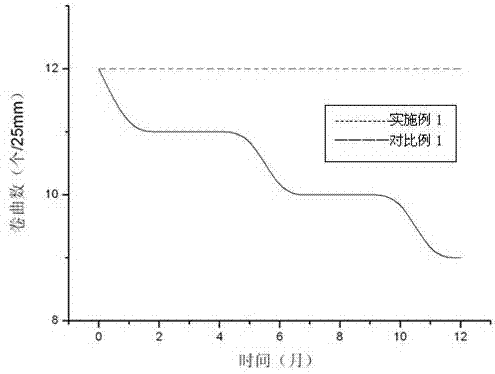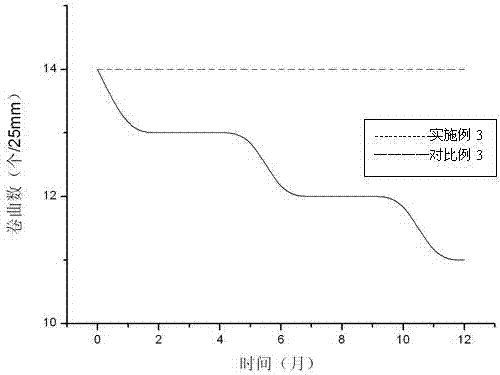Oils for improving morphological stability of textiles
A textile and stability technology, applied in the direction of textiles, papermaking, fiber treatment, etc., can solve the problems of poor shape stability, etc., and achieve the effects of strong deformation recovery, good shape stability, and good curling performance
- Summary
- Abstract
- Description
- Claims
- Application Information
AI Technical Summary
Problems solved by technology
Method used
Image
Examples
Embodiment 1
[0047] After the oil agent of the present invention is applied to the dry heat setting process of spandex textiles, the dry heat setting equipment is M-751 series setting machine, and the over-speed cloth feeding can reduce the radial tension of the textiles, which is beneficial to the expansion; To receive a certain retraction effect, the pin clip chain widening device is gradually widened by piercing the edge of the cloth with two ring-shaped pin clip chains. After the textile is pinned, it is then heated in a hot drying room and treated at 160°C for 20s to achieve the purpose of heat setting. Within 8 hours of heat setting, immerse the textile in the following oil for dilution. When the oil is used, it is mixed with water at 60°C and diluted 5 times. The weight proportion of the oil and oil is as follows:
[0048] 30 parts of ethylene oxide polyether,
[0049] 20 parts sodium dodecyl phosphate,
[0050]18 parts potassium alkyl ether sulfate,
[0051] 10 parts triolein, ...
Embodiment 2
[0060] After the oil agent of the present invention is applied to the dry heat setting process of polyester textiles, the dry heat setting equipment is M-751 series setting machine, and the over-speed cloth feeding can reduce the radial tension of the textiles, which is beneficial to the expansion; To receive a certain retraction effect, the pin clip chain widening device is gradually widened by piercing the edge of the cloth by two annular pin clip chains. After the textile is pinned, it is then heated in a hot drying room and treated at 170°C for 40s to achieve the purpose of heat setting. Within 4 hours of heat setting, immerse the textile in the dilution of the following oil, and dilute the oil with 50°C water by 8 times. The weight ratio of the oil and oil is as follows:
[0061] 40 parts of ethylene oxide polyether,
[0062] 30 parts sodium dodecyl phosphate,
[0063] 25 parts potassium alkyl ether sulfate,
[0064] 15 parts triolein,
[0065] 12 parts of succinic ac...
Embodiment 3
[0073] After the oil agent of the present invention is applied to the wet heat setting process of nylon textiles, steam is used for setting, and the knitted textiles are wound on a porous evacuable roller, and put into steaming for processing at a temperature of 130° C. and a time of 25 minutes. Within 1 hour of heat-setting, the textile is sprayed with a diluent oil used to improve the stability of the textile shape. The oil is diluted 15 times with water at 50°C. The weight proportion of the oil and oil is as follows:
[0074] 34 parts of ethylene oxide polyether,
[0075] 26 parts sodium dodecyl phosphate,
[0076] 20 parts potassium alkyl ether sulfate,
[0077] 12 parts triolein,
[0078] 10 parts of succinic acid penetrant,
[0079] Emulsifier OP-10 5 parts,
[0080] Alkyldiethanolamine 5 parts.
PUM
 Login to View More
Login to View More Abstract
Description
Claims
Application Information
 Login to View More
Login to View More - R&D
- Intellectual Property
- Life Sciences
- Materials
- Tech Scout
- Unparalleled Data Quality
- Higher Quality Content
- 60% Fewer Hallucinations
Browse by: Latest US Patents, China's latest patents, Technical Efficacy Thesaurus, Application Domain, Technology Topic, Popular Technical Reports.
© 2025 PatSnap. All rights reserved.Legal|Privacy policy|Modern Slavery Act Transparency Statement|Sitemap|About US| Contact US: help@patsnap.com



